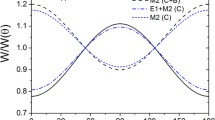Abstract
The angular correlation of the 133 keV-482 keV-yy-cascade in the decay of Hf181 is strongly attenuated if solid sources of hafniumammoniumhexafluoride are used. The unperturbed correlation was observed however when a single crystal of hafniumammoniumhexafluoride was used whose main axis pointed into the direction of one of the two detectors. This proves that the perturbation is static and that the maximum component of the electric field gradient at the position of the hafnium nucleus coincides with the direction of the main axis of the crystal.
The anisotropy of the angular correlation was measured as a function of the direction of the crystal axis. The results agree with the theoretical predicted functions for a strong electric quadrupole interaction.
Then we combined the intrinsic electric field with an external magnetic field. The magnetic field direction was chosen parallel to thez-axis of the electric field gradient and perpendicular to the plane of the detectors.
The theory for axially symmetric field gradients predicts a maximum of the anisotropy of the angular correlation for a magnetic field strength at which resonance exists between electric and magnetic precession. For a strong electric interaction the maxium anisotropy has half the value of the unperturbed correlation.
In our case the electric quadrupole interaction was so strong that we could not reach the resonance even when we applied external magnetic fields up to 48000 gauss. The observed anisotropies were too large however to be fitted by theoretical curves which were calculated under the assumption that the field gradient has axial symmetry. Therefore we developed the theory for non-axially symmetric electric field gradients. Now a fit was possible and gave unique solutions for the strength of the electric hyperfine interaction as well as for the asymmetry coefficient of the electric field gradient tensor.
The accuray of these results was not very high but the strength of the electric hyperfine interaction was found to be small enough to make a direct observation of the electric spin rotation by the differential angular correlation method possible. The observed pattern confirmed the non-axially symmetry of the electric field gradient and we derived the following parameters:
.
As the hafnium nucleus is strongly deformed, a value for the electric quadrupolemoment of the 482 keV state can be derived from coulomb excitation work. UsingQ(432 keV)=(2·45±0·1)·10−24 cm2 one gets the following absolute values for the electric field gradient tensor components:
.
Similar content being viewed by others
Author information
Authors and Affiliations
Additional information
Wir danken Herrn ProfessorJentschke für die Förderung unserer Untersuchungen und sein besonderes Interesse an den Ergebnissen.
Unser besonderer Dank gilt Herrn Professor A.Schröder vom Mineralogisch-Petrographischen Institut der Universität Hamburg für die Anleitung bei den Kristallstrukturuntersuchungen und für die Bereitstellung der dazu erforderlichen Apparaturen.
An den integralen Winkelkorrelationsmessungen waren alle Mitarbeiter der Hamburger Winkelkorrelationsgruppe beteiligt.
Wir danken Herrn Dr. W.Schneider von der Universität Upsala für seine Hilfe bei der Auswertung der differentiellen Messungen.
Das Ministerium für wissenschaftliche Forschung unterstützte diese Untersuchungen durch Bereitstellung finanzieller Mittel.
Rights and permissions
About this article
Cite this article
Mayer, L., Bodenstedt, E. & Günther, C. Untersuchung von elektrischer Hyperfeinstruktur-Wechselwirkung in Hafniumammoniumhexafluorid-Einkristallen durch γγ-Winkelkorrelationsmessungen. Z. Physik 177, 28–53 (1964). https://doi.org/10.1007/BF01375402
Received:
Issue Date:
DOI: https://doi.org/10.1007/BF01375402




